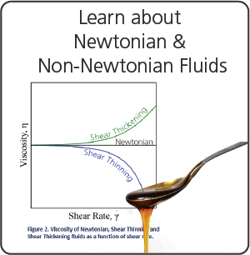Back to Basics Webinar Series: Viscosity Fundamentals
As viscosity experts we love to dive deep into complex rheological concepts. We may enjoy exploring complex concepts, but that does not mean we don't appreciate the basics! We know that without the fundamentals all those more advanced concepts mean nothing. Last month, we hosted our back to basics webinar series on non Newtonian vs. Newtonian behavior. In this webinar we distinguished the differences between Newtonian and non-Newtonian behavior. Newtonian fluids have a linear relation between shear stress (mPa-s) and shear rate (1/s), meaning viscosity remains constant regardless of shear rate. In contrast, Non-Newtonian fluids viscosity is dependent on shear rates. We also discussed the origins of non-Newtonian behavior (meaning the fluids viscosity is dependent on shear rate) and what viscosity data on these systems is telling you.
This month, we're taking a step back and going to the fundamental coverage of the different types of viscosity. Have you ever been confused by all the different types of viscosity? We understand it can be confusing since there not only several types of viscosity, but each with their own units.
You may have heard of the terms: dynamic, inherent, complex, but what are they? What do they all mean?
Dynamic viscosity (also known as absolute viscosity) is the measurement of the fluid’s internal resistance to flow while kinematic viscosity refers to the ratio of dynamic viscosity to density. This means two fluids with the same dynamic viscosities can have very different kinematic viscosities depending on density and vice versa. Great, now we understand the different viscosities (sort of), but what does all of this mean? How are these measurements applied?
Download our back to basics webinar discussing the different types of viscosities. Learn how they are defined, why they exist, and when to use them.

Want to learn even more about Newtonian and non-Newtonian behaviors? Download one of our application notes about



